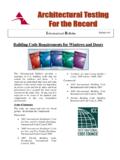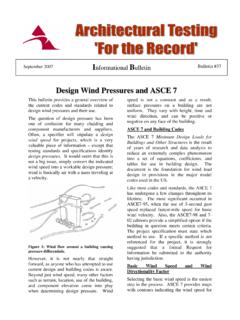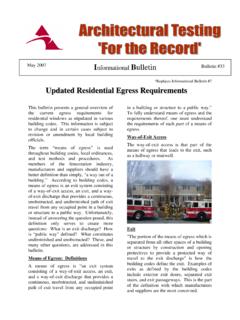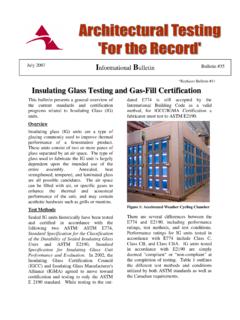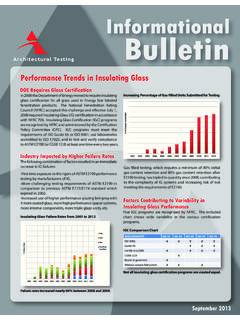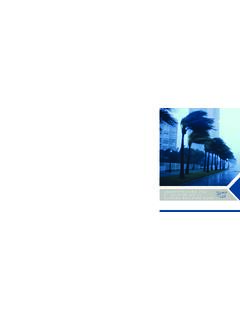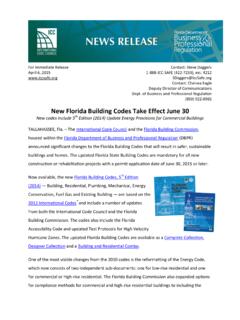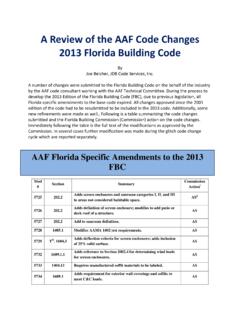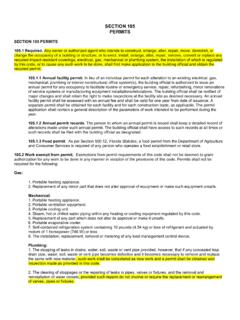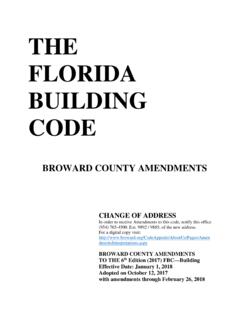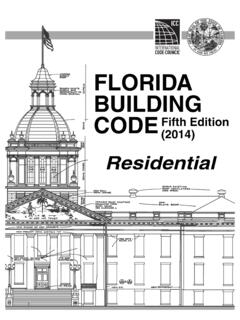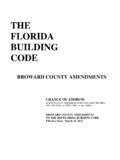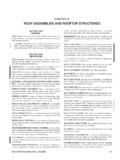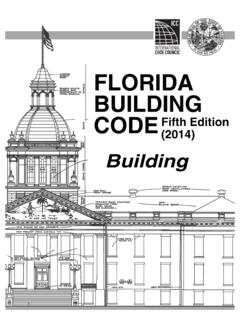Transcription of Updated Impact Requirements for Building …
1 Updated Impact Requirements for Building ComponentsThis Information Bulletin presents a general overview of the current Impact Requirements as stipulated in the 2010 florida Building code (FBC), the Texas Department of Insurance and the 2006, 2009, and 2012 International Building code (IBC) and International Residential code (IRC). This information is subject to change and in certain cases subject to revision or amendment by local Building o Building code , 2010: florida has two distinct regions requiring wind-borne debris protection: 1) High Velocity Hurricane Zone (HVHZ) and 2) Wind-Borne Debris Regions (WBDR). All Building envelope products sold in florida must be approved by the florida Product Approval Program. It should be noted that the 2010 FBC and 2012 IBC reference ASCE 7-10 which now uses an ultimate strength design approach to design wind pressure.
2 The 2010 FBC wind maps and corresponding WBDR are now based on ultimate design wind speeds. However, product testing is still conducted with respect to allowable stress design methodology. Thus, design pressures determined for ultimate wind speed must be converted to allowable stress design wind speed for the purpose of product Velocity Hurricane Zone: The FBC de nes HVHZ as Miami-Dade and Broward Counties. Here, county-wide basic wind speeds and Exposure C are mandated. Also, the entire Building envelope must be resistant to wind-borne debris. Large missile protection is required below 30' elevation, and small missile protection is required above 30' 2014 Reference should be made to FBC Section 1626, FBC Sections 2410 through 2415, FRC Section R301, and R4410.
3 All testing of products shall be performed to HVHZ Protocols TAS 201, TAS 202 and TAS Debris Regions: These regions are de ned as areas within one mile of the coastal mean high water line where the ultimate design wind speed is 130 mph or greater; and areas where the ultimate design wind speed is 140 mph or Risk Category II buildings and structures and Risk Category III buildings and structures (except healthcare facilities) the WBDR shall be based on Figure 1. For Risk Category IV buildings and structures and Risk Category III healthcare facilities, the WBDR shall be based on Figure 2. The ultimate design wind speed for use in the design of Risk Category I buildings and structure should be obtained from Figure 2014 Exterior glazing of doors and windows shall be Impact resistant or protected.
4 Large missile protection is required below 30' elevation, and small missile protec-tion is required between 30' elevation and 60' eleva-tion. Testing shall be performed to ASTM E1886-02 (or 05) and ASTM E1996-02 (or 06 or 09), or TAS 201 and TAS c provisions for storm shutter and exterior protective devices are found in FBC Section 2413. Section 2411 refers to windows, doors, glass and glazing; Section 2412 is for glass veneers; Section 2414 covers curtain walls; and Section 2415 references structural glazing Design Wind Speeds: Risk Category II & III Buildings and Structures (Except Healthcare Facilities)Figure Design Wind Speeds: Risk Category IV Buildings and Structures and Category III Health-care FacilitiesFigure Design Wind Speeds: Risk Category I Buildings and StructuresTexas Windstorm Insurance Association Texas Department of InsuranceSince January 1, 2008, the 2006 IRC and IBC, both with Texas Revisions, have been in e ect.
5 These rules apply to the designated 14-county coastal catastrophe area, which is divided into 3 zones. The zones are Seaward, Inland I and Inland II (Figure 4). All door and window products sold in the coastal catastrophe region must be tested, certi ed and labeled. The Texas Department of Insurance o ers a product evaluation service for these of the Intracoastal Canal, all unprotected exterior openings (windows, doors, skylights and garage doors) shall be Impact resistant and subject to 130 mph 3 second gust design. Inland I, located inland of the Intracoastal canal, is subject to the 120 mph 3-second wind gust design and all glazed exterior openings shall be protected or Impact resistant.
6 Inland II, located inland of the 120 mph contour, does not have Impact Requirements and design pressures are determined by 110 mph 3-second wind gust required to be Impact resistant will be tested to the large missile test if located between grade and 30' elevation and the small missile test if located between 30' and 60' elevation. The Feb 2014reference standards for Impact testing and fatigue cycling are ASTM E1886-04 and ASTM 4. Texas First Tier Coastal Counties Designated Catastrophe AreasInternational Building code , 2006/2009 Section Wind-borne Debris Region: Portions of hurricane-prone regions within 1 mile of the coastal mean high water line where the basic wind speed is 110 mph or greater; or portions of hurricane-prone regions where the basic wind speed is 120 mph or greater; or glazing of doors and windows shall be Impact resistant or protected.
7 Large missile protection is required below 30' elevation, and small missile protection is required above 30' elevation. Testing shall be performed to ASTM E1886-04 and ASTM E1996-04 for the 2006 IBC and ASTM E1886-06 and ASTM E1996-06 for the 2009 2006 and 2009 Codes have a requirement that windows are tested and labeled for air / water / structural performance, but there is only the testing requirement for wind-borne debris performance. Wind load resistance of shutters is proven by ASTM Building code , 2012 Section Wind-borne Debris Region, is de ned as areas within 1 mile of the coast mean high water line where the ultimate design speed is 130 mph or greater or in areas where the ultimate design speed is 140 mph or higher or glazing of doors and windows shall be Impact resistant or protected.
8 Large missile protection is required below 30' elevation, and small missileprotection is required between 30' elevation and 60' elevation. Testing shall be performed to the following: ASTM E1886-05 and ASTM E1996-09 for the 2012 2012 code has a requirement that windows are tested and labeled for air/water/structural performance, but there is only the testing require-ment for wind-borne debris performance. Wind load resistance of shutters is proven by ASTM information presented below for other states with coastal regions is per the International code Adoptions Map found at This information changes on a regular basis and is subject to local adoption. A useful summary chart is presented on Table 1 and Table Codes based on 2006 IBC/IRC* - 2010 Building code of New York State - Georgia - Louisiana - Texas (IRC - 2000) Building Codes based on 2009 IBC/IRC* - New Hampshire - Delaware - Maine - Massachusetts Building code - North Carolina State Building code - Alabama State Building code - Virginia Statewide Building code - Delaware Building code (jurisdictional based) - Alabama Statewide (IBC - also check for jurisdic-tional adoptions) - Louisiana - New Jersey Building CodeBuilding Codes based on 2012 IBC/IRC* - Mississippi (jurisdictional based) - South Carolina Building code - Maryland Building Performance Standards - Rhode Island State Building code *Note.
9 To ensure you have accurate information, please contact the jurisdiction .. graduate of Texas Tech University, Vinu holds the position of ATI Vice President - Southeast Region. He is a licensed professional engineer sought after by clients globally to address stringent windborne debris Requirements and aid in the development of protective glazing products that serve to safeguard homes, businesses, and communities from the e ects of severe storms and man made The AuthorVinu Abraham, ATI Vice President - Southeast RegionTable Impact Requirements for 2009 IBC/IRC, 2006 IBC/IRC and 2003 IBC/IRC*Note: 1. Wind Speeds are Allowable Design Stress methodology (ASCE 7-05)2. Design Pressure Based on 15 ft2, Wall Zone 5, Exposure C and 30 ft roof Wind Zone as de ned in ASTM E1996-094.
10 Pressures for > 140 based on 150 MPHT able Impact Requirements for 2012 IBC/IRC and 2010 florida Building code *Note: 1. Wind Speeds are Strength Design methodology (ASCE 7-10), Category II Design Pressure Based on 15 ft2, Wall Zone 5, Exposure C and 30 ft roof Design Pressures have been converted to Allowable Stress Design Methodology for comparison to design pressure ratings of Wind Zone as de ned in florida Building code , Section Pressures for > 170 MPH based on 180 MPHWind Speed (mph) Design Pressure (psf) Wind Zone Missile State TX LA GA NC VA DE NJ NY CT MA NH ME 100 + / N/A N/A X X X X X X X X X X X X 100 <110 + / N/A N/A X X X X X X X X X X X X 110 <120 + / 1 C X X X X X X X X X X 120 <130 + / 2 C X X X X X X X 130 <140 + / 3 D X X X X > 140 + / 4 D X Wind Speed (mph) Design Pressure (psf)
